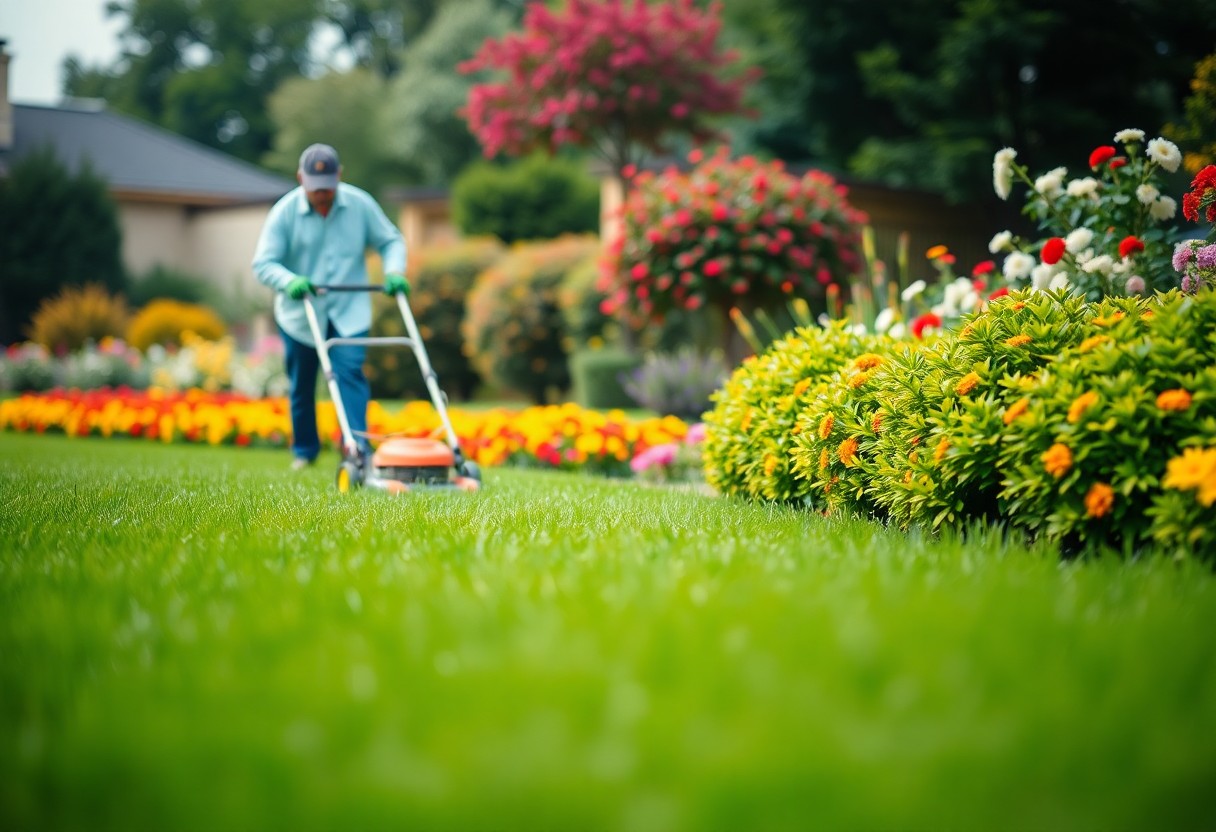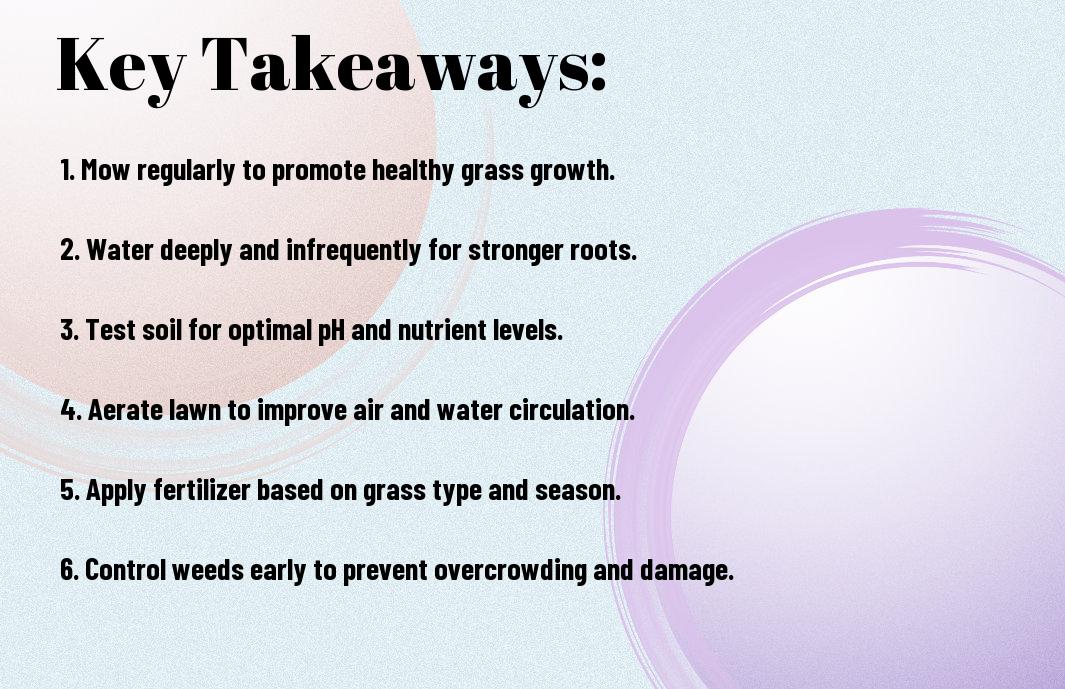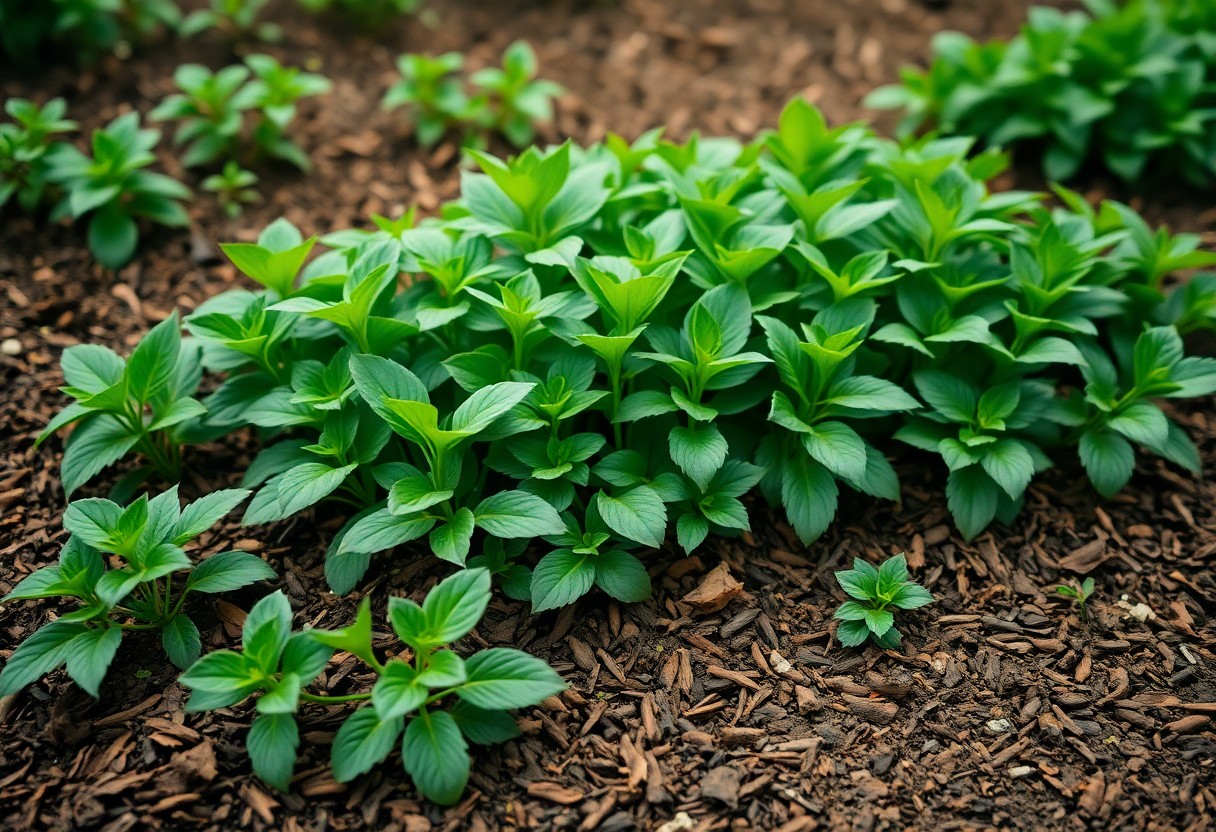You take pride in your lawn, and you want it to thrive. To achieve this, you need to focus on proper care. You can start by learning the basics, such as mowing, watering, and fertilizing. For a more detailed guide, you can check out 5 Steps to a Healthy Lawn to get your lawn in top shape. By following these tips, you will be on your way to a lush, green lawn that you can enjoy all year round.
Key Takeaways:
To keep your lawn looking its best, consider the following tips:
- Regular mowing is important for maintaining a healthy lawn, as it helps to promote even growth and prevent weeds from taking over. Aim to mow your lawn at least once a week during the growing season.
- Proper watering techniques are vital for keeping your lawn healthy and hydrated. Avoid overwatering, which can lead to shallow root growth and make your lawn more susceptible to disease.
- Applying fertilizer at the right time can give your lawn the nutrients it needs to thrive. Choose a fertilizer that is high in nitrogen, phosphorus, and potassium, and apply it during the growing season for optimal results.
Lawn Care Essentials
While a healthy lawn requires regular attention, you can achieve it with the right techniques. You’ll need to focus on basic care practices to keep your lawn thriving.
Mowing and Watering
Above all, proper mowing and watering habits are vital. You should mow your lawn regularly and water it deeply to promote healthy growth.
Fertilization and Pest Control
Controlling weeds and pests is key to a healthy lawn. You must apply fertilizers and pesticides at the right time to prevent damage to your grass.
But as you research deeper into fertilization and pest control, you’ll find that it’s not just about applying products. You need to consider your lawn’s specific needs, including the type of grass, climate, and soil conditions, to choose the right fertilizers and pest control methods, and apply them in a way that minimizes harm to the environment and your family.

Soil Quality
There’s no healthy lawn without good soil. You need to assess your soil type and adjust your care routine accordingly. Your soil’s composition and pH level will determine the right fertilizers and amendments to use.
pH Balance and Testing
Similar to soil composition, pH balance is vital for your lawn’s health. You should test your soil’s pH level regularly to ensure it’s optimal for your grass type.
Soil Amendments and Aeration
Soil structure can be improved with amendments like compost or manure. You can also aerate your soil to increase air and water circulation, promoting healthy root growth.
Another key aspect of soil care is maintaining proper nutrient levels. You can add fertilizers or organic matter to enrich your soil, but be careful not to overdo it, as this can harm your lawn. By monitoring your soil’s condition and making adjustments as needed, you’ll be on your way to a lush, thriving lawn.
Weed and Pest Management
Once again, you’ll need to take action to keep your lawn healthy. You must manage weeds and pests to prevent damage.
Identification and Removal
The key to a healthy lawn is identifying and removing weeds and pests. You can hand-pull weeds or use an herbicide, and pick off pests like white grubs and chinch bugs.
Prevention and Control Methods
Above all, preventing weeds and pests is better than treating them. You can use physical barriers, like mulch, or cultural controls, like proper mowing and watering, to prevent them.
Control methods include using targeted herbicides or insecticides, introducing beneficial insects, or practicing good sanitation. You can also use organic methods, like neem oil or diatomaceous earth, to control pests and weeds, keeping your lawn healthy and lush, with minimal effort from you.
Lawn Aesthetics
All lawns require attention to detail to maintain their visual appeal. You can achieve this by keeping your lawn well-manicured and incorporating decorative elements.
Gardening and Landscaping
Growing beautiful plants and flowers around your lawn enhances its beauty. You can add trees, shrubs, and flower beds to create a unique landscape.
Outdoor Lighting and Decor
Across your lawn, you can add lighting and decorations to create ambiance. You can use solar-powered lights and decorative items like bird baths and sculptures.
Another aspect of outdoor lighting and decor is highlighting your lawn’s best features. You can use spotlights to accentuate certain areas, like a garden or water feature, making your lawn more inviting and visually appealing to you and your guests.
Seasonal Maintenance
For a healthy lawn, you’ll need to adapt your maintenance routine to the changing seasons. This means adjusting your mowing, watering, and fertilizing schedule to match the time of year.
Spring and Summer Care
Above all, your lawn needs regular mowing and watering during spring and summer. You’ll want to keep your grass at a moderate height and ensure it gets enough moisture to withstand the heat.
Autumn and Winter Preparation
Autumnally, your lawn will start to prepare for dormancy, and you’ll need to adjust your care accordingly. You’ll want to reduce mowing and fertilizing, and focus on cleaning up leaves and debris.
Considering the colder months ahead, you’ll want to take steps to protect your lawn from damage. You’ll need to aerate the soil, apply a winterizer fertilizer, and keep an eye out for disease and pests that can damage your lawn during this time. By taking these steps, you can help your lawn stay healthy and strong until the growing season starts again.
Common Lawn Problems
Now that you’ve taken steps to maintain your lawn, you’ll need to identify potential issues. Your lawn can be affected by various problems, including disease, pests, and environmental factors. You’ll need to monitor your lawn regularly to catch these issues early.
Disease and Fungal Issues
For healthy grass, you’ll want to watch out for diseases like powdery mildew and rust. These can spread quickly, damaging your lawn. You can prevent them by improving air circulation and reducing moisture.
Insect and Pest Infestations
Frequently, your lawn may be invaded by insects like white grubs and chinch bugs. These pests can cause significant damage, so you’ll need to take action quickly. You can use natural methods or pesticides to control infestations.
For instance, if you notice unusual damage or discoloration, you may have an insect or pest problem. You can inspect your lawn carefully to identify the issue and choose the best solution. You’ll need to consider the type of pest, the size of the infestation, and the best treatment method to protect your lawn.

Conclusion
Taking this into account, you’ve learned what it takes to keep your lawn healthy. You now know the basics to make your yard thrive. With these tips, you can create a lush outdoor space that brings you peace and satisfaction. Your lawn will be the envy of the neighborhood, and you’ll enjoy the fruits of your labor. You’ve got the tools, now get to work and make your lawn the best it can be.
FAQ
Q: What is the best way to water my lawn to keep it healthy?
A: The best way to water your lawn is to do it deeply but infrequently. This encourages the roots of the grass to grow deeper, making the lawn more resistant to drought and disease. Aim to provide about 1-2 inches of water per week, either from rain or irrigation. It’s also best to water your lawn in the early morning or late evening to minimize evaporation and reduce the risk of fungal diseases.
Q: How often should I mow my lawn to maintain its health?
A: The frequency of mowing depends on the type of grass and the growth rate. As a general rule, it’s best to maintain your lawn at a height of 2.5-3 inches. For most grass types, this means mowing about once a week during the growing season. However, it’s also important not to cut more than one-third of the grass blade in a single mowing, as this can stress the lawn. Adjust your mowing schedule according to the growth rate of your lawn and the season.
Q: What type of fertilizer is best for my lawn, and when should I apply it?
A: The best type of fertilizer for your lawn depends on the type of grass, the soil pH, and the time of year. A balanced, slow-release fertilizer (e.g., 10-10-10 NPK) is a good choice for most lawns. For cool-season grasses, apply fertilizer in the fall to promote root growth and prepare the lawn for the next growing season. For warm-season grasses, apply fertilizer in the late spring to early summer to promote growth during the active growing season. Always follow the instructions on the fertilizer package and perform a soil test to determine the specific needs of your lawn.
Q: How can I control weeds in my lawn without using chemical herbicides?
A: Controlling weeds without chemical herbicides requires a combination of cultural, mechanical, and organic methods. Improving the overall health and density of your lawn through proper mowing, watering, and fertilization can help suppress weeds. Mechanical methods include hand-weeding, using a tool like a hoe for larger areas, and applying mulch or landscaping fabric to prevent weed seeds from germinating. Organic herbicides, such as those based on vinegar or soap, can also be effective. Regularly maintaining your lawn and addressing weeds as soon as they appear can prevent them from becoming a major issue.
Q: How often should I aerate my lawn to maintain its health and appearance?
A: Lawn aeration is an necessary maintenance practice that helps improve air, water, and nutrient circulation to the roots of the grass. For most lawns, aeration is needed once a year. The best time to aerate depends on the type of grass: for cool-season grasses, aerate in the fall, while for warm-season grasses, aerate in the late spring to early summer. Aeration can be done manually with a fork for small lawns or with a mechanical aerator for larger areas. It’s also a good idea to combine aeration with other lawn care practices, such as applying fertilizer or overseeding, to maximize the benefits.



